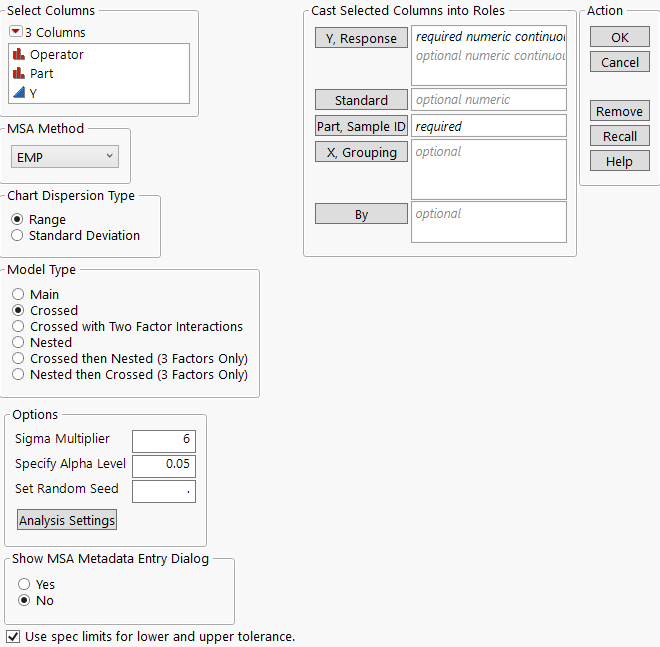Launch the Measurement Systems Analysis Platform
Launch the Measurement Systems Analysis platform by selecting Analyze > Quality and Process > Measurement Systems Analysis.
Figure 4.5 The Measurement Systems Analysis Window
For more information about the options in the Select Columns red triangle menu, see Column Filter Menu in Using JMP.
The Measurement Systems Analysis window contains the following features:
Select Columns
Lists all of the variables in your current data table. Move a selected column into a role.
MSA Method
Select the method to use: EMP (Evaluating the Measurement Process), Gauge R&R, or Type 1 Gauge. This chapter covers the EMP method. For more information about the Gauge R&R method, see Variability Gauge Charts. For more information about the Type 1 Gauge method, see Type 1 Gauge Analysis.
Chart Dispersion Type
Designates the type of chart for showing variation. Select the Range option or the Standard Deviation option.
Note: For the EMP method, the chart dispersion type determines how the statistics in the EMP Results report are calculated. If the Range option is selected, and you have a one factor or a two factor, balanced, crossed model, the statistics in this report are based on ranges. Otherwise, the statistics in this report are based on standard deviations.
Model Type
Designates the model type:
Main
Variables with nominal or ordinal modeling types are treated as main effects.
Crossed
The model is crossed when every level of every factor occurs with every level of every other factor.
Crossed with Two Factor Interactions
The model is crossed when each level of two factors occurs with every level of the other factor.
Nested
The model is nested when all levels of a factor appear within only a single level of any other factor.
Crossed then Nested (3 Factors Only)
The factors are crossed and then nested for 3 factors.
Nested then Crossed (3 Factors Only)
The factors are nested and then crossed for 3 factors.
Options
Contains the following options:
Sigma Multiplier
Specifies the sigma multiplier used in the analyses.
Specify Alpha Level
Specifies the 1-alpha confidence level used in the analyses.
Set Random Seed
Enables you to set a specific random seed.
Analysis Settings
Opens a window that enables you to set the REML maximum iterations and convergence limit.
Show MSA Metadata Entry Dialog
Specifies if the MSA Metadata dialog is shown after you click OK. This dialog enables you to load the metadata from a data table or enter the metadata for each column manually. Use the following options to enter the metadata manually:
Choose Tolerance Entry Type
Choose to enter the tolerance range directly or specify the lower and upper tolerance values. If you choose to enter lower and upper tolerance values, the tolerance range is calculated as the difference between the upper and lower tolerance values. If only one tolerance value is entered, the tolerance range cannot be calculated and any statistics in the report that rely on the tolerance range are not shown.
Tolerance Range
Specifies the tolerance for the process, which is the difference between the upper specification limits and the lower specification limits.
Lower Tolerance
Specifies the lower tolerance limit. This is used to calculate the tolerance range if it is not specified directly.
Upper Tolerance
Specifies the upper tolerance limit. This is used to calculate the tolerance range if it is not specified directly.
Historical Mean
Specifies a historical mean. The historical mean is used to compute tolerance ranges for one-sided specification limits (either USL-Historical Mean or Historical Mean-LSL). If you do not enter a historical mean, the grand mean is used.
Historical Process Sigma
Specifies a historical process sigma. This value is used to calculate the process variation in the Linearity and Bias Results option and some of the statistics in the Gauge R&R report.
Tip: This data can also be specified prior to launching using the MSA column property. You can set MSA column properties to several measurement columns at once using Manage Limits. See Manage Limits.
Use Spec Limits for Tolerance if Needed
If a tolerance range is not specified for a column, but the column has a Spec Limits column property, this option uses the specification limits to calculate the tolerance range.
Y, Response
The column(s) of measurements.
Standard
Specifies a standard or reference column that contains the “true” or known values for the measured part. Including this column enables the Bias and Linearity Study options. These options perform analysis on the differences between the observed measurement and the reference or standard value. See Linearity and Bias Results.
Part, Sample, ID
The column designating the part or unit.
X, Grouping
The column(s) representing grouping variables.
By
Identifies a column that creates a report consisting of separate analyses for each level of the variable.
Data Format
To use the Measurement Systems Analysis platform, all response measurements must be in a single response column. Sometimes, responses are recorded in multiple columns, where each row is a level of a design factor and each column is a level of a different design factor. Data in this format must be stacked before running the Measurement Systems Analysis platform. See Stack Columns in Data Tables in Using JMP.
